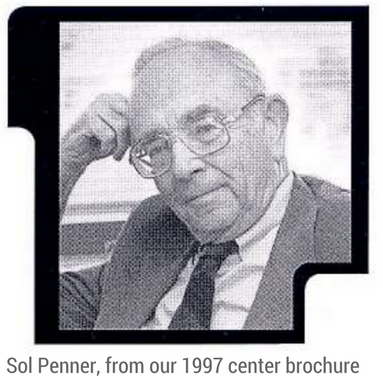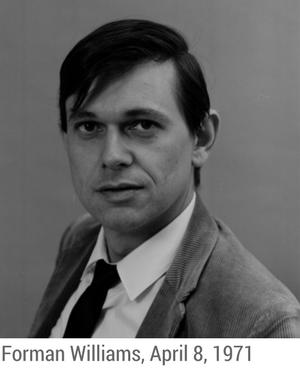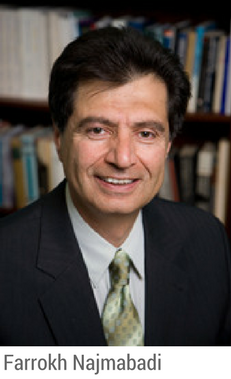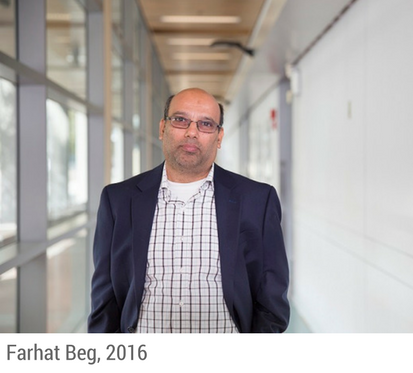
The UC San Diego "Energy Center" commenced operation informally during the fall of 1972 under the impetus of Professor Sanford (Sol) S. Penner. Originally from Germany, Dr. Penner immigrated to the US when he was 15. Early mentorships with prominent scientists laid the foundation for an exciting career that included researching rocket engines for the US Army during WWII, teaching at Caltech University, and founding two scientific journals. Dr. Penner came to UC San Diego in 1963 as the founding chair of the University’s first engineering department, Aeronautical and Mechanical Engineering Sciences.
 A trip around the world in the early 1970s convinced Dr. Penner of the central importance of energy issues and led him to create the Energy Center. On July 1, 1974 the Energy Center was formally designated an organized research unit; an official university entity that facilitates interdisciplinary research by providing its members with administrative and financial support. Dr. Penner worked with graduate students and experts from academia, industry and government to publish a series of studies in energy conservation, shale-oil recovery, coal conversions, fuel cells, the hydrogen economy, nuclear reactors, and fusion energy. Dr. Penner was an early addressor of climate change, and explored the use of reflective particles to block solar energy in papers dating back to 1983.
A trip around the world in the early 1970s convinced Dr. Penner of the central importance of energy issues and led him to create the Energy Center. On July 1, 1974 the Energy Center was formally designated an organized research unit; an official university entity that facilitates interdisciplinary research by providing its members with administrative and financial support. Dr. Penner worked with graduate students and experts from academia, industry and government to publish a series of studies in energy conservation, shale-oil recovery, coal conversions, fuel cells, the hydrogen economy, nuclear reactors, and fusion energy. Dr. Penner was an early addressor of climate change, and explored the use of reflective particles to block solar energy in papers dating back to 1983.
 In 1986, the Energy Center was renamed the Center for Energy and Combustion Research (CECR), in order to underscore the close link between energy and combustion research. Professor of Mechanical and Aerospace Engineering, Forman A. Williams, succeeded S. S. Penner as director in 1990. Dr. Williams received his PhD in Engineering Sciences from Caltech University in 1958- he was a student of Sol Penner- and taught at Harvard and Princeton Universities before coming to UC San Diego. Dr. Forman enriched the Center with his research expertise in combustion. His book Combustion Theory, first published in 1965, is widely considered the most authoritative work on the subject. Dr. Forman also helped broaden the scope of the Center by merging it with two other UC San Diego entities, The Fusion Energy Research Program (FERP) and the Virtual Laboratory for Technology (VLT).
In 1986, the Energy Center was renamed the Center for Energy and Combustion Research (CECR), in order to underscore the close link between energy and combustion research. Professor of Mechanical and Aerospace Engineering, Forman A. Williams, succeeded S. S. Penner as director in 1990. Dr. Williams received his PhD in Engineering Sciences from Caltech University in 1958- he was a student of Sol Penner- and taught at Harvard and Princeton Universities before coming to UC San Diego. Dr. Forman enriched the Center with his research expertise in combustion. His book Combustion Theory, first published in 1965, is widely considered the most authoritative work on the subject. Dr. Forman also helped broaden the scope of the Center by merging it with two other UC San Diego entities, The Fusion Energy Research Program (FERP) and the Virtual Laboratory for Technology (VLT).
 The FERP group formed in 1994 after UCLA Engineering Professor, Robert Conn, accepted a position as Dean of UCSD’s Jacobs School of Engineering. Dr. Conn brought with him to UC San Diego core members of his Institute of Plasma and Fusion Research Institute team, many of whom are still part of CER. Dr. Conn also recruited Charles C. Baker, the U.S. team leader for ITER, an international project to design a working fusion energy reactor. After the U.S. discontinued its participation in ITER, many of Dr. Baker’s team continued as members of The Virtual Laboratory for Technology, a national organization created to coordinate all fusion technology work in the country. The combination of these different energy-related activities into a single entity expanded the scope of the center and prompted a name change to the Center for Energy Research (CER).
The FERP group formed in 1994 after UCLA Engineering Professor, Robert Conn, accepted a position as Dean of UCSD’s Jacobs School of Engineering. Dr. Conn brought with him to UC San Diego core members of his Institute of Plasma and Fusion Research Institute team, many of whom are still part of CER. Dr. Conn also recruited Charles C. Baker, the U.S. team leader for ITER, an international project to design a working fusion energy reactor. After the U.S. discontinued its participation in ITER, many of Dr. Baker’s team continued as members of The Virtual Laboratory for Technology, a national organization created to coordinate all fusion technology work in the country. The combination of these different energy-related activities into a single entity expanded the scope of the center and prompted a name change to the Center for Energy Research (CER).
On July 1, 2006, Farrokh Najmabadi, Professor of Electrical and Computer Engineering, became the 3rd director of the Center. Dr. Najmabadi received his B.S. in electrical engineering from Tehran University, and his PhD in nuclear engineering from UC Berkeley. He served as a Principal Institute Scientist under Robert Conn at UC Los Angeles’s Institute of Plasma and Fusion Research until 1994, when he joined UC San Diego as a professor of electrical and computer engineering. As recommended in the 15-year review of the Center, Dr. Najmabadi was committed to broadening the Center's research agenda. From 2009-2015 the center expanded its research portfolio to include fuel cell, solar energy forecasting, and energy storage.
 On July 1, 2015, Farhat Beg, Professor of Mechanical and Aerospace Engineering, became the 4th Director of the Center. Prof. Beg received his B.S. and M. Sc. in Physics and Mathematics from Quaid-i-Azam University, and his Ph.D. in Plasma Science from Imperial College London. In 2003, he joined the faculty at the Department of Mechanical and Aerospace Engineering, University of California at San Diego, La Jolla. Dr. Beg has been fellow of the American Physical Society since 2009 and the Institute of Electronics and Electrical Engineers (IEEE) since 2011. He is the recipient of the IEEE Early Career Award and the Department of Energy Junior Faculty Award. He has published over 200 articles in refereed journals and conference proceedings including, Nature, Nature Physics, Nature Communications, and Physical Review Letters among others. His publications are highly cited with total citations over 5000, and an H-index of 40, according to the Web of Knowledge.
On July 1, 2015, Farhat Beg, Professor of Mechanical and Aerospace Engineering, became the 4th Director of the Center. Prof. Beg received his B.S. and M. Sc. in Physics and Mathematics from Quaid-i-Azam University, and his Ph.D. in Plasma Science from Imperial College London. In 2003, he joined the faculty at the Department of Mechanical and Aerospace Engineering, University of California at San Diego, La Jolla. Dr. Beg has been fellow of the American Physical Society since 2009 and the Institute of Electronics and Electrical Engineers (IEEE) since 2011. He is the recipient of the IEEE Early Career Award and the Department of Energy Junior Faculty Award. He has published over 200 articles in refereed journals and conference proceedings including, Nature, Nature Physics, Nature Communications, and Physical Review Letters among others. His publications are highly cited with total citations over 5000, and an H-index of 40, according to the Web of Knowledge.
Archives
Check out these official CER documents that date back to the early 1970s!
- A list of publications from the early days of CER (PDF)
- First Center Director Sol Penner’s published papers from 1983-1993, exploring solutions to climate change (PDF)
- Our Center brochure from circa 1997 (PDF)
Center Reports
- 2004 (circa)- Report of the CER Sunset Review Committee (PDF)
- 2004 - CER Proposal for Continuation (PDF)
- 2001- Charting the Course of CER from 2005-2010 (PDF)
- 2000-2002 (PDF)
- 2000- Proposal for name change from CECR to CER (PDF)
- Center for Energy & Combustion Research (PDF)
- 1997-1998 (PDF)
- 1996-1997 (PDF)
- 1995-1996 (PDF)
- 1993-1994 (PDF)
- 1992-1993 (PDF)
- 1991-1992 (PDF)
- 1986-1987 (PDF)
- 1984-1989 (PDF)
- 1974-1979 (PDF)
- 1974-1975 (PDF)
